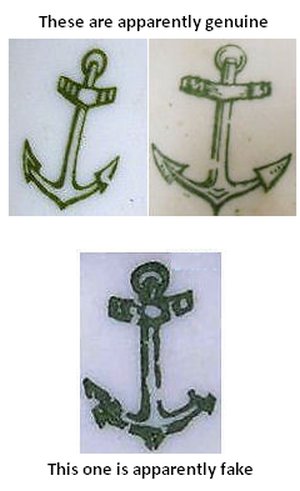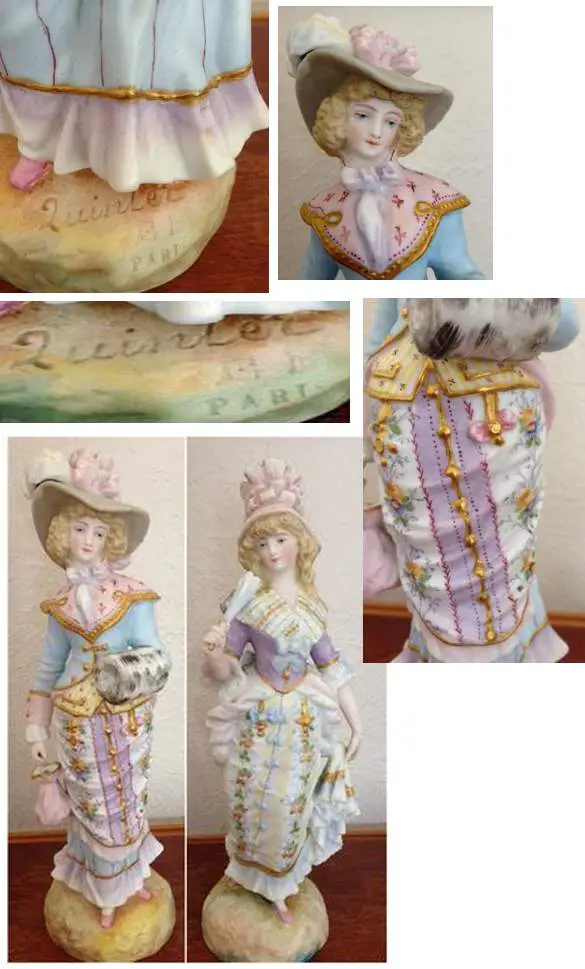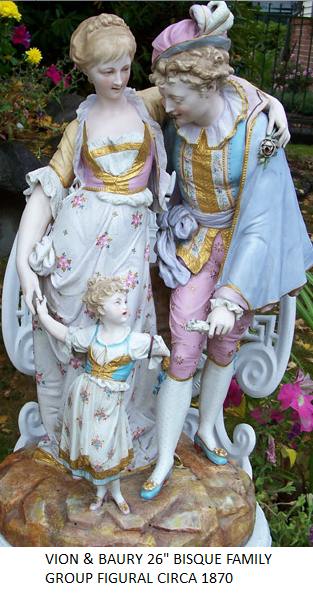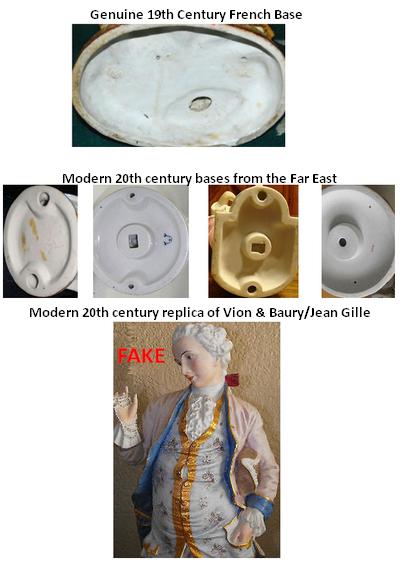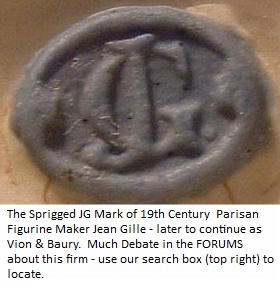Anchor mark on Romeo & Juliet Porcelain Figurines pre 1920
by Martha
(Denver, CO)

Anchor mark on Romeo & Juliet Porcelain Figurines pre 1920
Anchor mark on Romeo & Juliet Porcelain Figurines pre 1920:- These belonged to my grandparents, who were from New York City and he travelled the east coast as a salesman -- so I am thinking they MIGHT be by Anchor Pottery (of Trenton NJ).
Approximately 18" high, each of the figures bears a black anchor mark in its base. And each is signed(?) "Chapuis".
Any help in identifying the maker would be appreciated...
Thanks!
Martha
============================================
Please contribute to this thread by writing in the comments section below – just scroll down...
 |
Anchor mark on Romeo & Juliet Porcelain Figurines pre 1920
Hi Martha
Nice clear pics, thanks. The actual anchor pottery mark on this figurine looks more like the marks of Thomas Maddock & sons of Trenton NJ (TM&S) in terms of the shape and style than the Anchor Pottery backstamp.
However, the items themselves look European, not really American, or at least I have not really seen examples of American sculpture & decoration like this. But not being an expert I learn everyday from site visitors and the expert appraisals they commission.
Any thoughts, please post. Interesting submission. Is this Samson of Paris, for example?
======================================
UPDATE:-
I have been fascinated by this query for some time, and wanted it solved (because this is very interesting ceramic and sculptural work) so did a lot more digging.
I have found this anchor mark attributed (but normally in green - see the photos from an anonymous contributor below) elsewhere online to a small and little known, but very high quality Parisian maker called Vion & Baury (V & B) located in the Rue de Paradis-Poissonniere and originally founded in 1845 by a ceramic sculptor called Jean Gille.
Accounts say Gille died in 1867 and the two men took over the business renaming it Vion & Baury.
Here's what I have pieced together from various sources online....
Jean Gille seems to sometimes be referred to as Gille Jeune (presumably meaning Gille Jnr or Gille the younger). He was a modeller of great skill by all accounts.
Beginning his own business in 1845 he grew his business upon the fad of the time for highly detailed and characterful, realistic and colourful bisque (unglazed) figurines.
Some of the figurines I have seen from this period which have a blue raised JG pottery mark backstamp, are really very well modelled - actually breathtaking to see for a professional modern modeller like me.
It seems he was successful enough to take on junior modellers into his stable and the best of these was a Charles Baury.
When Gille died in 1867 Baury, along with Désiré Vion (who by some accounts was a fellow modeller and by others was another small manufacturer) took over the business.
From what I can gather their first mark was very similar to the raised blue JG mark - instead with the monogram VB. I think (and I am only surmising as more
Then, by all accounts, by the 1880's the fad for the large bisque Parisian figure was waning and the studio went into slightly more mass production, or at least a bit more volume than before.
This later period is apparently where the green anchor comes in (needs citing & evidence) - it appears to denote slightly less exacting modelling and production standards to allow for a slightly lower appeal in terms of price point and market. All of which would make sense.
The anchor mark on the above photos sent in by Martha, does not appear to be green though (although you can never tell with digital pics).
Apart from green, I have not seen any other anchor mark mentioned in relation to Vion & Baury (apart from the photos below on this page, see an example in another listing here www.figurines-sculpture.com/green-anchor-mark).
So there we have it. Martha's items are characteristic of other items described with an anchor mark Vion et Baury of Paris that I have seen online.
However, I recently had a very similarly decorated item but with a different mark come through the expert appraisal service and the expert insisted it was mid to late 20th century, not 19th century V & B. It is the faces that are the give away, apparently Go here to see the evidence (scroll to the bottom of the page for my post)
I have seen some of the genuine JG and V & B figures apparently selling for four figure sums, other in the high hundreds. The real Gille and also Baury modelling and decoration is different class when you see it beside the above items.
This leaves this whole area open to an industry of clever fakes, so tread carefully. I can't tell whether the more mass produced looking figures are later V & B or modern.
I feel the artist 'Chapuis' (signature shown above on Martha's photo) is part of this later phase of V & B style wares, as I don't think they are as good as the ones I have seen attributed to older more carefully made Baury and Gille, especially the lady is not anywhere near in the same class. And I would even go as far as to say it looks almost as bad as a modern rip off (perhaps a bit harsh, but just my opinion).
The lady shown below is much better in my view, but the expert says this style of painting on the face looks to him like a 20th century painted face.
We would welcome any input on this - please post in the comments link below.
The discussion below is shown, as it unfolded, unedited, so interesting to see the thought processes from various contributors before we knew what we know now....
======================================
END UPDATE
Peter (admin)
p.s. The following page is a 'must see' if you are researching fine china - for value and identification:-
Researching the identity and value of antique and vintage fine china.
Comments for Anchor mark on Romeo & Juliet Porcelain Figurines pre 1920
|
||
|
||
|
||
|
||
|
||
|
||
|
||
|
||
|
||
|
||
|
||
|
||
|
||
|
||









